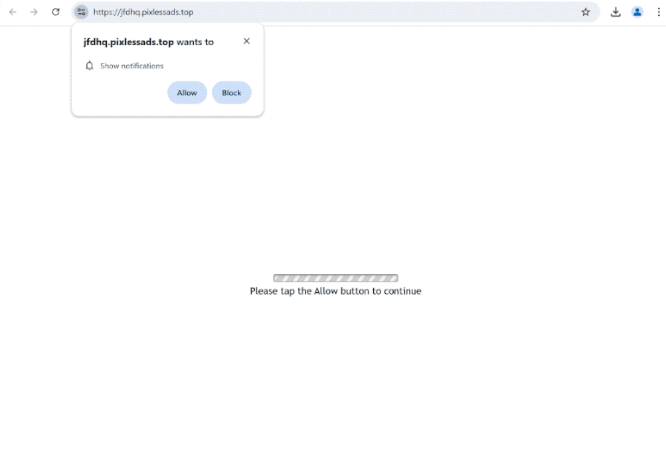Remove pixlessads.top notifications
pixlessads.top is a deceptive website that intends to trick users into allowing ads on the desktop. To do that, it misuses a legitimate browser feature, which is why you will get a browser alert saying “pixlessads.top wants to show notifications ” when you get redirected to the site. Do not click “Allow” as the site will start spamming ads on your desktop if you do.
The website pixlessads.top displays no content other than a loading bar and a prompt instructing users to click “Allow” to continue. As soon as you enter the site, a browser notification appears asking if you want to allow notifications from pixlessads.top. If you click “Allow”, you will grant the site permission to show ads directly on your screen. These ads can sometimes mimic legitimate system notifications to deceive users into engaging with them. For example, the ads could mimic virus alerts and ask you to install something. It’s worth mentioning that these notifications could lead you to potentially malicious websites that promote scams or hide malware. Fortunately, if you’ve already enabled notifications from this site, it’s easy to revoke that permission.
While the “show notifications” feature is frequently exploited by websites like pixlessads.top, it can have legitimate uses. For instance, if you regularly visit a trustworthy website and want to see more of its content, you may choose to allow notifications. If you later decide you no longer want to get them, revoking permission is straightforward.
To ensure your device’s security, consider scanning it with an anti-virus program like WiperSoft, as adware may be causing unwanted redirects. Installing an adblocker program is also a good idea.
What triggers redirects to sites like pixlessads.top
Redirects to websites like pixlessads.top often occur because users visit ad-heavy websites without an adblocker program installed on the device. Adware can also cause these redirects, though it’s rare. In most cases, it’s because users browse certain websites that spam ads. For example, sites that have pirated or pornographic content tend to expose users to as many ads as possible. Fortunately, using an adblocker program can effectively block both ads and redirects.
If adware is responsible, you should experience frequent redirects no matter which sites you visit. While it’s generally a minor infection, it will quickly get on your nerves. Adware, browser hijackers, and similar infections often come bundled with popular free programs. This bundling process involves adding these unwanted infections as optional offers to other programs. These offers are set to install automatically, but they are optional. However, to prevent the offers from installing, users must manually deselect them. This can be challenging since they are often hidden in less frequently used settings. This is why software bundling is considered to be a controversial method. Most anti-virus programs label software that uses the bundling method as potential threats.
To avoid unwanted installations, pay close attention when installing programs. You’ll have the option to choose your installation settings. While the installation window defaults to recommending Default settings, selecting these settings permits all bundled offers to install automatically. Instead, opt for Advanced settings, which will clearly outline any additional offers included. You can then easily uncheck any you don’t want. It’s advisable to deselect all offers, even if they seem beneficial at first. Allowing these additional installations can clutter your computer with unwanted programs, which might be challenging to remove later on.
How to stop pixlessads.top redirects
Use the WiperSoft anti-virus program to scan your computer as adware may be responsible for the redirects you’re experiencing. Using an anti-virus program is the most straightforward way to get rid of adware. Additionally, installing an adblocker program will help prevent ads and unwanted redirects in the future.
If you’ve granted a site permission to send you notifications, you can easily revoke it. Should you need help navigating your browser’s settings, instructions are provided below. Besides removing pixlessads.top, remove all other unfamiliar websites as well. If you’d like to stop receiving notifications altogether, you can turn off this feature altogether.
- For Mozilla Firefox: Open Menu (the three bars top-right corner) -> Options -> Privacy & Security. Scroll down to Permissions, press Settings next to Notifications, and remove pixlessads.top and any other questionable websites. You can permanently turn off these notification requests by checking the “Block new requests asking to allow notifications” box in the same Notifications settings.
- For Google Chrome: Open Menu (the three dots top-right corner) -> Settings -> Privacy and security -> Site Settings. Click on Notifications under Permissions, and remove pixlessads.top and any other questionable websites. You can stop these notification requests permanently by toggling off “Sites can ask to send notifications”.
- For Microsoft Edge: Open Menu (the three dots top-right corner) -> Settings -> Cookies and site permissions -> Notifications. Review which sites have permission and remove pixlessads.top and any other questionable websites. You can permanently turn off these notification requests by toggling off “Ask before sending”.
Site Disclaimer
WiperSoft.com is not sponsored, affiliated, linked to or owned by malware developers or distributors that are referred to in this article. The article does NOT endorse or promote malicious programs. The intention behind it is to present useful information that will help users to detect and eliminate malware from their computer by using WiperSoft and/or the manual removal guide.
The article should only be used for educational purposes. If you follow the instructions provided in the article, you agree to be bound by this disclaimer. We do not guarantee that the article will aid you in completely removing the malware from your PC. Malicious programs are constantly developing, which is why it is not always easy or possible to clean the computer by using only the manual removal guide.

